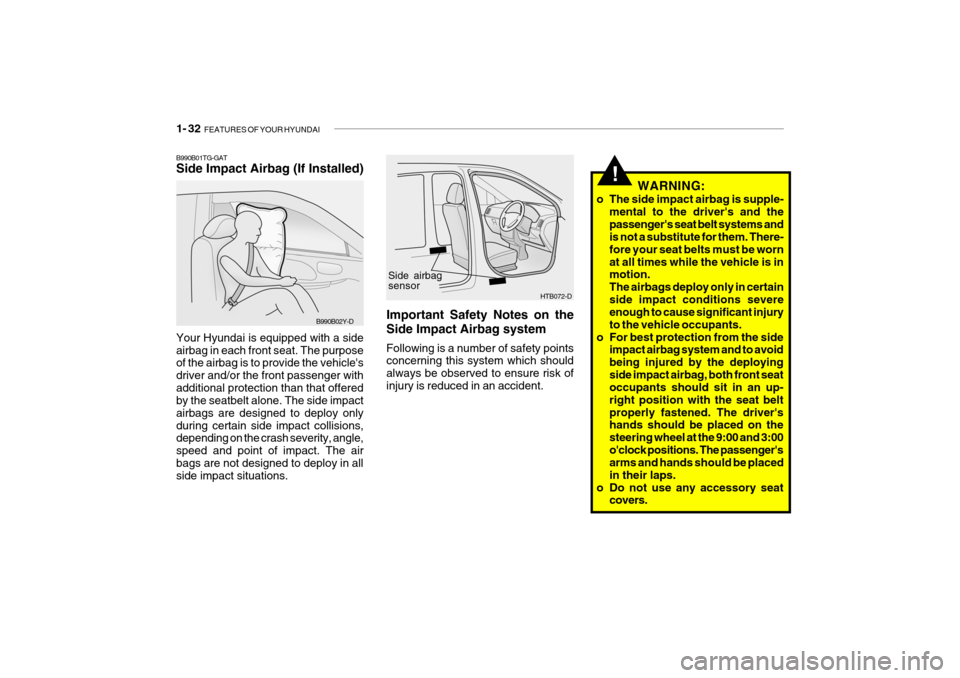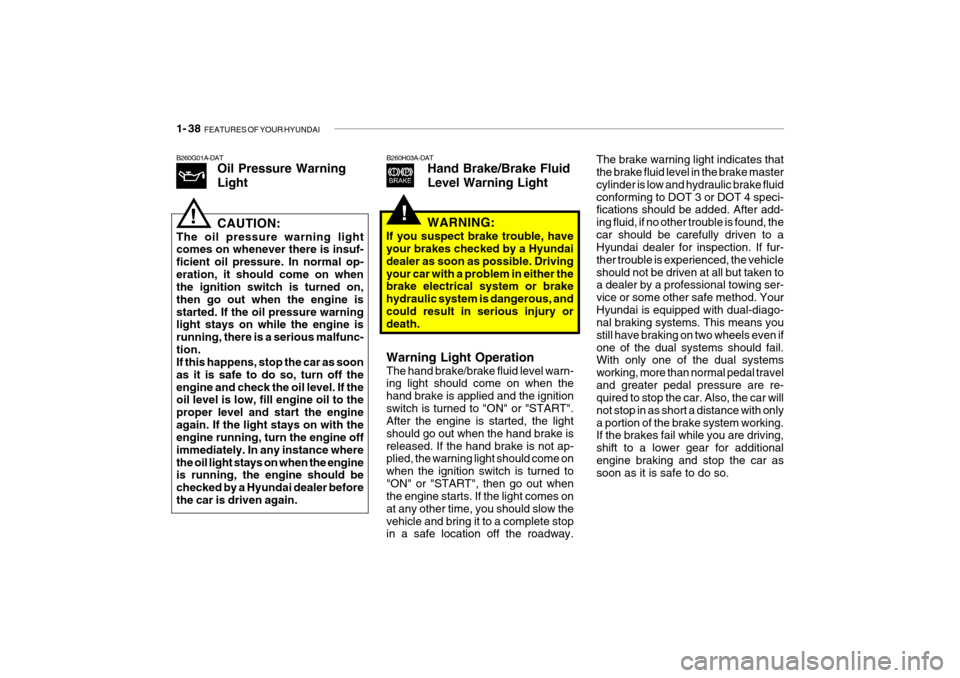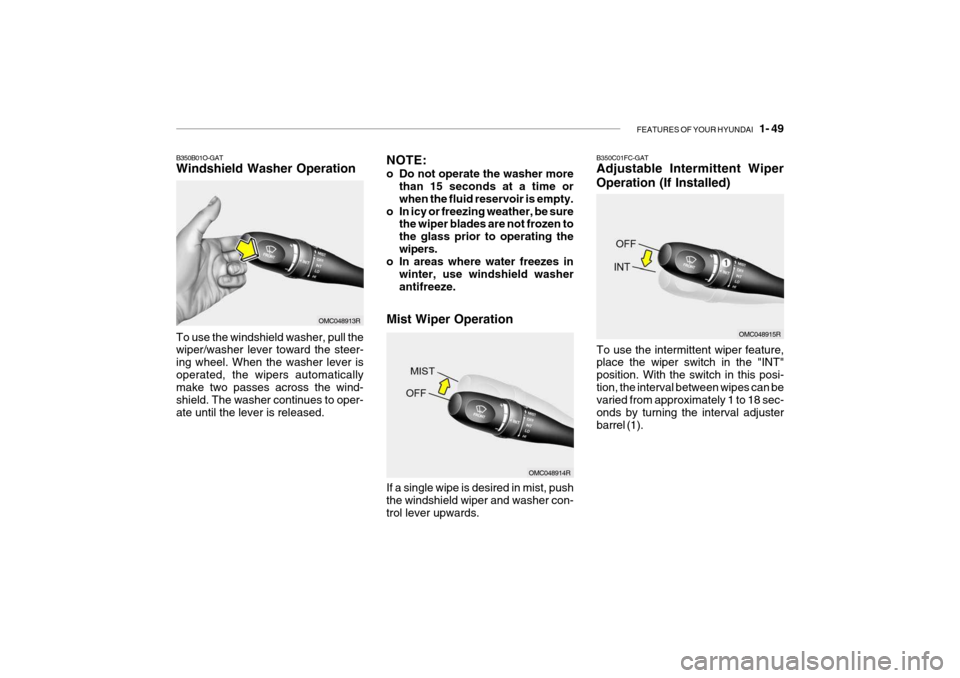2009 Hyundai Getz wheel
[x] Cancel search: wheelPage 39 of 191

1- 28 FEATURES OF YOUR HYUNDAI
B240B01TB
Driver's Airbag
Your vehicle is equipped with a Supple- mental Restraint (Air Bag) System and lap/shoulder belts at both the driver andpassenger seating positions. The indi- cations of the system's presence are the letters "SRS AIR BAG" embossedon the airbag pad cover in the steering wheel and printed on the passenger's side front panel pad above the glovebox. B240A03TB-DAT SUPPLEMENTAL RESTRAINT (AIRBAG) SYSTEM (If Installed)
WARNING:
o As its name implies, the SRS is designed to work with, and be supplemental to, the driver's and the passenger's three point seat belt systems and is not a substi-tute for them. Therefore your seat belts must be worn at all times while the vehicle is in motion. Inaddition, the airbags deploy only in certain frontal impact condi- tions severe enough to likelycause significant injury to the vehicle occupants.
o The SRS is designed to deploy the airbags only when an impactis sufficiently severe and when the impact angle is less than 30°from the forward longitudinal axis of the vehicle and will not deploy in side, rear or rollover impacts.Additionally, the airbags will only deploy once. Thus, seat belts must be worn at all times.
The Hyundai SRS consists of airbags installed under the pad covers in the centre of the steering wheel and thepassenger's side front panel above the glove box. The purpose of the SRS is to provide the vehicle's driver and/or thefront passenger with additional protec- tion than that offered by the seat belt alone, in case of a frontal impact ofsufficient severity. NOTE: Be sure to read information about the SRS on the labels provided on the backside of the sun visor.
!
Page 41 of 191

1- 30 FEATURES OF YOUR HYUNDAI
The SRS service reminder indicator (SRI) on the instrument panel will blink for about 6 seconds after the ignitionkey is turned to the "ON" position or after the engine is started, after which the SRI should go out. The airbag modules are located both in the centre of the steering wheel and in the front passenger's panel above theglove box. When the SRSCM detects a considerable impact to the front of the vehicle, it will automatically deploy theairbags.
Passenger's Airbag
Upon deployment, tear seams molded directly into the pad covers will sepa- rate under pressure from the expan-sion of the airbags. Further opening of the covers then allows full inflation of the airbags. A fully inflated airbag in combination with a properly worn seat belt slowsthe driver's or the passenger's forward motion, thus reducing the risk of head or chest injury. HTB204-D
B240B02L-DB240B03L-D
Page 43 of 191

1- 32 FEATURES OF YOUR HYUNDAI
!
B990B01TG-GAT Side Impact Airbag (If Installed) Your Hyundai is equipped with a side airbag in each front seat. The purpose of the airbag is to provide the vehicle's driver and/or the front passenger withadditional protection than that offered by the seatbelt alone. The side impact airbags are designed to deploy onlyduring certain side impact collisions, depending on the crash severity, angle, speed and point of impact. The airbags are not designed to deploy in all side impact situations.
B990B02Y-D
HTB072-D
Side airbag sensor
Important Safety Notes on the Side Impact Airbag system Following is a number of safety points concerning this system which should always be observed to ensure risk ofinjury is reduced in an accident. WARNING:
o The side impact airbag is supple- mental to the driver's and thepassenger's seat belt systems and is not a substitute for them. There- fore your seat belts must be wornat all times while the vehicle is in motion. The airbags deploy only in certainside impact conditions severe enough to cause significant injury to the vehicle occupants.
o For best protection from the side impact airbag system and to avoidbeing injured by the deployingside impact airbag, both front seat occupants should sit in an up- right position with the seat beltproperly fastened. The driver's hands should be placed on the steering wheel at the 9:00 and 3:00o'clock positions. The passenger's arms and hands should be placed in their laps.
o Do not use any accessory seat covers.
Page 44 of 191

FEATURES OF YOUR HYUNDAI 1- 33
!WARNING:
o Extreme Hazard! Do not use a rearward facing child restraint on a seat protected by an airbag in front of it!
o Modification to SRS components or wiring, including the additionof any kind of badges to the pad cover or modifications to thebody structure, can adversely affect SRS performance and lead to possible injury.
B240C01HP
B240C02A-DAT SRS Care The SRS is virtually maintenance-free and so there are no parts you cansafely service by yourself. The entire SRS system must be inspected by an authorised Hyundai dealer in 10 yearsafter the date that the car was manu- factured. Any work on the air bag system, such as removing, installing, repairing, or any work on the steering wheel mustbe performed by a qualified Hyundai technician. Improper handling of the airbag system may result in seriouspersonal injury.
o Use of seat covers could reduce or
prevent the effectiveness of thesystem.
o Do not install any accessories on the side or near the side impactairbag.
o Do not use excessive force on the side of the seat.
o Do not place any objects over the
airbag or between the airbag and yourself.
o Do not place any objects (an
umbrella, bag, etc.) between thefront door and the front seat. Such objects may become dangerousprojectiles and cause injury if the supplemental side impact air bag inflates.
o To prevent unexpected deploy- ment of the side impact air bagthat may result in personal in-jury, avoid impact to the side airbag sensor when the ignition key is on.
Page 45 of 191

1- 34 FEATURES OF YOUR HYUNDAI
o Do not install a child restraint sys-
tem in the front passenger seat position. A child restraint systemmust never be placed in the front seat. The infant or baby could be severely injured by an airbag de-ployment in case of an accident.
o If components of the air bag sys-
tem must be discarded, or if thevehicle must be scrapped, cer- tain safety precautions must be observed. Your Hyundai dealerknows these precautions and can give you the necessary informa- tion.Failure to follow these precau- tions and procedures could in- crease the risk of personal in-jury.
o If you sell your vehicle, be sure to
inform the new owner of theseimportant points and make cer- tain that this manual is trans- ferred to the new owner togetherwith the vehicle.
o If your car was flooded and has
soaked carpeting or water onflooring, you shouldn't try to start engine; have the car towed to authorised Hyundai dealer.o For cleaning the horn pad, useonly a soft, dry cloth or one which has been moistened with plainwater. Solvents or cleaners could adversely affect the airbag cover and proper deployment of thesystem.
o No objects should be placed over
or near the label identifying theair bag on the steering wheel and instrument panel, because any such object could cause harm ifthe vehicle is in a crash severe enough to cause the air bag to inflate.
o If the air bag inflates, it must be replaced by an authorisedHyundai dealer.
o Do not tamper with or discon- nect SRS wiring, or other com-ponents of the SRS system. Do-ing so could result in injury, due to accidental firing of the airbags or by rendering the SRS inopera-tive.
Page 49 of 191

1- 38 FEATURES OF YOUR HYUNDAI
The brake warning light indicates that the brake fluid level in the brake master cylinder is low and hydraulic brake fluidconforming to DOT 3 or DOT 4 speci- fications should be added. After add- ing fluid, if no other trouble is found, thecar should be carefully driven to a Hyundai dealer for inspection. If fur- ther trouble is experienced, the vehicleshould not be driven at all but taken to a dealer by a professional towing ser- vice or some other safe method. YourHyundai is equipped with dual-diago- nal braking systems. This means you still have braking on two wheels even ifone of the dual systems should fail. With only one of the dual systems working, more than normal pedal traveland greater pedal pressure are re- quired to stop the car. Also, the car will not stop in as short a distance with onlya portion of the brake system working. If the brakes fail while you are driving, shift to a lower gear for additionalengine braking and stop the car as soon as it is safe to do so.
!
B260H03A-DAT
Hand Brake/Brake Fluid Level Warning Light
Warning Light Operation The hand brake/brake fluid level warn- ing light should come on when the hand brake is applied and the ignitionswitch is turned to "ON" or "START". After the engine is started, the light should go out when the hand brake isreleased. If the hand brake is not ap- plied, the warning light should come on when the ignition switch is turned to"ON" or "START", then go out when the engine starts. If the light comes on at any other time, you should slow thevehicle and bring it to a complete stop in a safe location off the roadway. WARNING:
If you suspect brake trouble, haveyour brakes checked by a Hyundai dealer as soon as possible. Drivingyour car with a problem in either the brake electrical system or brake hydraulic system is dangerous, andcould result in serious injury or death.
B260G01A-DAT
Oil Pressure Warning Light CAUTION:
The oil pressure warning light comes on whenever there is insuf- ficient oil pressure. In normal op-eration, it should come on when the ignition switch is turned on, then go out when the engine isstarted. If the oil pressure warning light stays on while the engine is running, there is a serious malfunc-tion. If this happens, stop the car as soon as it is safe to do so, turn off theengine and check the oil level. If the oil level is low, fill engine oil to the proper level and start the engineagain. If the light stays on with the engine running, turn the engine off immediately. In any instance wherethe oil light stays on when the engine is running, the engine should be checked by a Hyundai dealer beforethe car is driven again.
!
Page 60 of 191

FEATURES OF YOUR HYUNDAI 1- 49
B350C01FC-GAT Adjustable Intermittent Wiper
Operation (If Installed)
To use the intermittent wiper feature, place the wiper switch in the "INT" position. With the switch in this posi-tion, the interval between wipes can be varied from approximately 1 to 18 sec- onds by turning the interval adjusterbarrel (1).
Mist Wiper Operation
If a single wipe is desired in mist, push the windshield wiper and washer con- trol lever upwards.
To use the windshield washer, pull the wiper/washer lever toward the steer- ing wheel. When the washer lever isoperated, the wipers automatically make two passes across the wind- shield. The washer continues to oper-ate until the lever is released.
B350B01O-GAT Windshield Washer Operation
NOTE:
o Do not operate the washer more
than 15 seconds at a time or when the fluid reservoir is empty.
o In icy or freezing weather, be sure the wiper blades are not frozen tothe glass prior to operating thewipers.
o In areas where water freezes in
winter, use windshield washerantifreeze.
OMC048913R
OMC048914R
OMC048915R
Page 80 of 191

FEATURES OF YOUR HYUNDAI 1- 69
!
B610B01A-DAT HORN
Press the centre hub of the steering wheel to sound the horn. B240B01TBB600A01A-AAT STEERING WHEEL TILT LEVER (If Installed)To Adjust the Steering Wheel:
1. Push the lever downward to unlock.
2. Raise or lower the steering wheel to
the desired position.
3. After adjustment, securely tighten the lever by pulling it upward.
WARNING:
Do not attempt to adjust the steer- ing wheel while driving as this mayresult in loss of control of the ve- hicle which may cause serious in- jury or death.
!
Your Hyundai is equipped with sun visors to give the driver and front pas- senger either frontal or side ward shade.The sun visors are fitted on both sides on all models. To reduce glare or to shut out direct rays of the sun, turn thesun visor down to block the annoy- ance. A ticket holder is provided on the back of the sun visor for the driver.Vanity mirrors are provided on the back of the sunvisor for the driver and the front passenger (If installed). NOTE: The Supplemental Restraint Sys- tem (SRS) label containing useful information can be found on the front of each sun visor.
WARNING:
Do not place the sun visor in such a manner that it obscures visibility of the roadway, traffic or other ob-jects.
B600A01TB